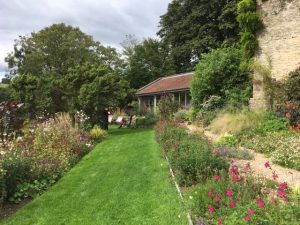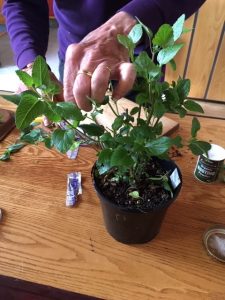
My mind returns immediately to the seat in the White garden when thinking about the
garden at Park Cottage. It is a place of tranquility, secrecy, privacy and surprise.
The seat is white, simple and striking in contrast to the surrounding dark foliage. It is
inviting and intriguing along the path. There is the added mystery of a surprise path behind
it leading to the rainbow garden.
It is a place to sit and think; to take in the darkness beneath the jasmine and its wafting
exotic scent. Whenever there is sunshine the foliage casts intricate patterns of shade onto
the seat and terracotta tiles below. From here enjoy the borders full of cloudy blooms beside
the simple, straight path towards the variegated trachelospermum arbour at the far
end.
The garden gets full sun throughout the summer months and low beams cast across it in
spring and autumn. The flowers glow in overcast weather; and are magical as the light
fades and at night the moon bathes it in silver.
It is a haven for butterflies and birds that flit and twitter though the hedges. In winter the
song of the robin fills the air and hunger entices them down to join the gardener. Tits nest
close by and flocks of tiny finches tumble into trees and shrubs, squabbling and calling. In
summer swallows swoop and dive and as autumn arrives the clatter of crows and pheasants
break through the misty mornings. Buzzards mew across the fields, a reminder that
this garden is surrounded by farmland.
At Park Cottage nothing has happened by accident. The White Garden on one side and the
green of the Jungle on the other linked by the Rainbow Border, splitting white into the
spectrum of colours through the prism beneath the jasmine and curving behind the Games
Lawn. Each area is complete whilst contributing to the whole.
I find the garden restful and calming. The simplicity of both the layout and the colour
scheme helps create this effect. There is a feeling of stillness and permanency, of coming
home. The planting structure ensures there are flowering plants for the longest time possible
with foliage and grasses providing interest throughout the year.
Spring is heralded by early flowering narcissi joining tiny violas which somehow persist
throughout the coldest weather followed by foxgloves which scatter seed amongst campanula,
wallflowers and centaurea flowering in late spring through to early summer. Peonies add flounce and impossibly white dicentra make an early and long flowering appearance
whilst herbaceous plants begin to emerge in the warmer, lighter days.
In summer the herbaceous perennials opulently fill the borders in vast clumps – phlox,
larger campanula, veronicastrum and lysimachia clethroides. Providing height. clematis
and roses scramble over each other up rustic fashioned supports amongst drifts of thalictrum
and everlasting sweet peas. Annuals grown from seed and plug plants fill in any gaps
along with glamorous dahlias which have over wintered in the greenhouse.
As the days shorten right until the first frosts the perennials keep flowering with regular
deadheading. Late flowering penstemons and bidens give a final last show and then, only
then, the exotic nerines appear when everything else has given up.
The planting in these border gives structure and abundance. They look mature and full.
Repeat planting enhances the effect plants contribute, the rhythm pleases to the eye.
consideration has been given to the size, shape and height. There is reassuring formality:
the black limestone straight path; parallel euonymous hedges either side, the dark yew
backdrop and square pillars of clipped leylandii and within these constraints plants of exuberance
and romance.
By Jacqui Haigh
WRAG trainee
Park Cottage, Somerset.
 My Basket
My Basket



